“Intellectual lucubrations”: Lamberto Vitali, Giorgio Morandi, and Metaphysical Art
Erica Bernardi Erica Bernardi Metaphysical Masterpieces 1916–1920: Morandi, Sironi, and Carrà, Issue 4, July 2020https://italianmodernart.org/journal/issues/metaphysical-masterpieces-1916-1920-morandi-sironi-and-carra/
Why didn’t Lamberto Vitali praise the artistic products of Morandi’s metaphysical phase as he did for works completed at other moments of the artist’s career? In Vitali’s writings on Morandi – in, for example, the different editions of his catalogue raisonné – the art historian doesn’t explicitly declare a preference. However, there is an evident change in the way he discusses the works of the artist’s metaphysical years (1918–1919). For instance, when he writes about the artist’s landscapes painted in the following years, between 1921 and 1925, he claims that they have a “tender sweetness in the representation, very far from the intellectual lucubrations of the Metaphysical Still Life.” This apparently banal and marginal question allows us, on the contrary, to consider Vitali’s reading of Morandi’s œuvre with a far broader perspective for which it becomes pivotal to take into consideration the collecting taste of the time. Through this reading of Vitali’s texts and of Morandi’s images, as well as an analysis of the contemporary market tendencies, it becomes possible to define the cultural reasons underlying Vitali’s taste.
Defining Lamberto Vitali’s taste as a collector and an “amateur” art historian is not so simple, for many reasons.1 To start with, he bought various pieces for various purposes, and was sometimes more of a collector than a historian, sometimes vice versa. He was broadly curious, and when he found a deal, his merchant instinct prevailed. He collected archaeological pieces from the Middle East and Eastern Asia; medieval Western sculptures; primitive Italian paintings; works by Macchiaioli artists such as Adriano Cecioni, Silvestro Lega, and Giovanni Fattori;2 and engravings and drawings by nineteenth-century French painters and Amedeo Modigliani.3 And of course, he collected works by Giorgio Morandi, who became, over the years, a dear friend, as did Marino Marini and Giacomo Manzù.4 Any attempt to put Vitali’s eclectic temperament and clever mind into a box would be futile, for it is impossible to crystallize him in a straightforward manner. More generally, we can say that he was interested in artifacts of an ancient grammar as well as objects modern in feeling. Only through this perspective we can understand how a Fayum portrait from ancient Egypt could be placed beside a Modigliani head (figures 1 and 2). He searched for quality, but did not want a collection of just famous artworks and artists. This choice reveals Vitali’s natural instinct as a collector: he chose what was “easily” collectable not only for reasons of interest, but also – obviously – in relation to the price of the object.
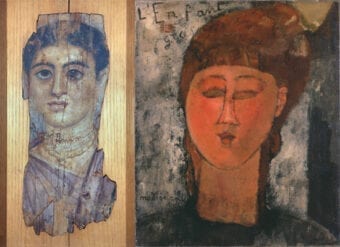
Amedeo Modigliani, “Enfant gras,” 1915. Oil on canvas, 17 15/16 x 14 3/4 in. (45.5 × 37.5 cm). Pinacoteca di Brera, Milan.
In the discussion that follows, I will attempt to describe Vitali’s approach to collecting by drawing on the publicly available documents concerning the donation of his collection to Milan’s Pinacoteca di Brera in 2001. Because many of his personal papers remain in private hands, the full extent of his collection is still to be revealed. For the time being, the most viable way to approach Vitali’s collecting practices – including his acquisition of works that could be called Metaphysical – is to read his available writings for explicit statements.
Born in Milan on November 22, 1896, to a family hailing from Livorno, Vitali was one of four brothers.5 He lived in Milan for most of his life, until his death in 1992, with two periods of exception that should be noted here. The first, from 1912 to 1914, followed his studies at the Technical Institute in Milan, when his father, a merchant, sent him to work with Oskar Reinhardt as a salesman in Germany.6 Reinhardt was both a merchant and a collector, and became an important point of reference for Vitali. The second period was during the Second World War, when, due to his Jewish origins, he was exiled to Switzerland. In 1938, in response to racial laws prohibiting his work as a businessman, he assigned the property of his company to his wife, who was not Jewish. After the promulgation of the Italian racial laws, he and his family fled to Tuscany.7 In September 1938, he returned to Milan, but soon after left for Switzerland for several years, aided by Fernanda Wittgens, who was at that moment the Brera’s director, and the collector Gianni Mattioli. Vitali returned to Italy in July 1945, after spending time in a refugee camp where he taught art history and got to know Marino Marini, the future theater director Giorgio Strehler, the philologist Dante Isella, and the architect Ernesto Nathan Rogers, among numerous other noteworthy prisoners.
Vitali’s status as an “amateur” art historian commenced when he began writing for several magazines in the 1920s, including L’Ambrosiano, Le arti plastiche, Emporium,8 Poligono, L’Italia letteraria, and Il caffè.9 In the 1930s he started a very important collaboration with Domus, the architecture and design magazine directed in those years by Gio Ponti.10 He was very active as a writer throughout the 1920s and 30s, often addressing topics not really at the center of discourse in those years, from photography to engraving in the nineteenth and the twentieth centuries.11
A number of Vitali’s writings reveal, with great transparency, his preferences and aversions in assembling his art collection. In a text about the donation to the Brera of works from the Jesi collection, he wrote:
The history of ancient and recent art collection teaches that there are two totally opposite ways to form a collection: either by desiring to minutely document the art of a specific period, with the attendant risk of putting together artworks that are completely different from one another but conceived in the same time frame, or the gathering of fruits of civilizations both very distant in time as well as more recent, and conceived in the most remote places, which actually, due to their importance, use similar languages.12
The second-mentioned approach to collecting certainly better represents his own. As an “old” way of looking not only for big names, his was really more of a nineteenth-century search for a fil rouge in art history. It resembled the Lithuanian-American art historian Bernard Berenson’s collecting style, which highly influenced the American approach: Americans bought art already thinking about museums. Indeed, in New York in 1948 and 1949, Vitali met Alfred Barr, Jr., and James Thrall Soby, of the Museum of Modern Art. Both had been educated through the museology courses of Paul J. Sachs at Harvard University.13
Vitali started to buy art in the 1920s, when Milan was central to the exchange of Italian art and, arguably, became the birthplace of the market as we know it today. In the beginning, Milanese galleries catered to a wide range of tastes. During the 1930s in particular, they promoted groups of nineteenth-century artists, such as the Macchiaioli and the Divisionists, as well as works by innovative twentieth-century artists, including various members of the Novecento group promoted by Margherita Sarfatti. In this sense, a kind of generational exchange was taking place, involving complex crossroads. Vitali was interested in both axes of this network. He frequented galleries in Milan and internationally, notably in Paris and London.14 But he remained for all his life a man born in the previous century, with precious taste, and looking for rich materiality, intense inspiration, and classical references. He struggled to understand many contemporary artists, as is evident in a number of the texts he published in Domus in the 1930s. Particularly in his contributions “Artisti e pubblico” (Artists and Audience, 1934) and “Crisi della pittura” (Crisis of Painting, 1935), he expressed without reticence his negative judgment of a certain kind of contemporary art that cut off any relation with the past,15 quoting Henri Focillon to support his position: “The practice of painting is no longer a mystery, and has become an amusement; its future is certain as long as it rediscovers its magical character.”16
When Vitali was acquiring objects, his intentions could be various – they did not follow a single reasoning. Further, shaping his choices as of a certain moment were his thoughts on Milanese museums and what they lacked, and he took advantage of his frequent international business trips to pursue this motivation.17 He distinguished two kinds of galleries (typified by Adolphe Goupil and Ambroise Vollard) that corresponded to two types of buyers:
The first kind worries about financing artists who are close to the public’s current taste, pleasant and bourgeois artists, who tantalize with easy, merely superficial, and illusory graces [whereas] the other is not concerned with instantaneous fortune, but works for the future, preceding, in a certain sense, even the discoveries and assessments of the most assured critics.18
He recognized himself as the kind of buyer sought after by the second type of gallery. But the assessment is his own self-representation: Vitali wanted to see himself as a brave patron of contemporary young talent, but in fact he was not, for his preferences favored a mild avant-garde.
After the Second World War, his intention to contribute to the expansion of Milan’s collections intensified, increased by his strengthened sense of civic duty after the injustices he suffered due to his Jewish heritage. With Reinhardt’s model in mind, he was already envisioning donations.19 Gillo Dorfles wrote in a brief text about Vitali – his friend – that he never thought he was generous, except when it came to museums.20
Vitali had been part of a community that tried to counteract Fascism, or just to survive it; after the war, they worked to not only to reconstruct Milan, culturally the most damaged Italian city (five museums were destroyed; the Scala and Leonardo’s Last Supper were also severely hit), but also to put it culturally on the map, at the center of Europe.21 This group of antifascists was united around the Pinacoteca di Brera, after its complete destruction during the bombings in 1943,22 along with four other museums. (The Scala theater was severely damaged, too.) Milan, even today, is not known as a city of art, and it is probably for this reason that the Italian government underestimated the devastation, neglecting to put the Brera on the list of monuments in need of prompt intervention.23
Vitali was responsible along with Ettore Modigliani – the Brera’s director between 1908 and 1934, and from 1946 to 194724 – for the founding, in 1926, of the Amici di Brera e dei Musei milanesi, inspired by the Societè des Amis du Musée de Gand (founded in 1897). This patronage association’s purpose was to enlarge the Brera’s collections to the size of a museum like, in Vitali’s words, “the big National Gallery [in Rome], but to showcase the pictorial Northern Schools, to fill the gap in this field and better represent the artists already in the collections.” Vitali was a member of the association from the very beginning, and in the 1970s became its president. After Modigliani’s pupil Fernanda Wittgens became his successor at the museum, between 1947 and 1957, Vitali worked with Wittgens on behalf of the Brera’s collections to ensure donations to the museum;25 he continued his efforts during Franco Russoli’s directorship, from 1957 to 1977. Vitali survived all of these museum leaders, and the dialogue continued with subsequent directors. He was there from 1925 to 1992 – longer than any Brera employee – and he faithfully transmitted the museum’s original mission.
His highly important contribution to the continuity that characterized the Brera during the twentieth century permitted an extraordinary expansion of the collections. Indeed, as president of the Amici di Brera during the 1970s, he worked with Russoli to realize the project of the “grande Brera,” including acquisitions from the most important private collectors in Milan – among others, Emilio Jesi, Ricardo Jucker, Gianni Mattioli, and Giuseppe Panza di Biumo. The “grande Brera,” a long and productive collaboration, started with Modigliani’s idea of enlarging the collections of this national museum, and in December 1949, after the war’s end, Wittgens restarted the Amici di Brera for this very reason, immediately appointing Russoli as secretary of this association of trustees.26 One of the most important contributions to the Pinacoteca during Vitali’s presidency was the purchase of a painting by Giovanni da Milano in 1971 (figure 3), a fundamental Lombard artist who could not be excluded from the most important Milanese museum.27
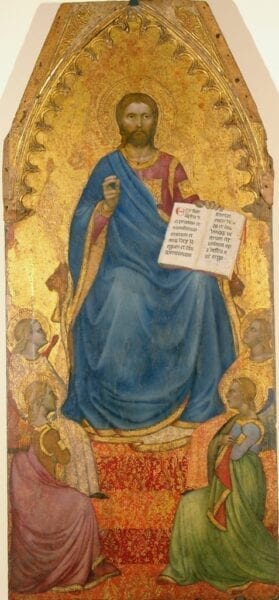
Vitali was convinced that the Brera should enlarge its collections with nineteenth-century painters, namely, the beloved Macchiaioli and the Lombard Divisionists.28 In 1948, along with Wittgens and others, Vitali worked on the exhibition Dipinti dell’Ottocento italiano (Paintings of the Italian Nineteenth Century), held in Lugano at Villa Ciani.29 At the time, Wittgens made the following statement: “In the program of the Brera the first necessity is to renew the nineteenth-century section to adjust it in relation to the newest studies.”30 Vitali’s first list of donations to the Brera included works by Medardo Rosso, Giovanni Fattori, Silvestro Lega, Telemaco Signorini, and Adriano Cecioni. Clearly, in acquiring works over the years, he was already thinking about the Milanese museums, and he looked for a modern nineteenth century as represented in works emerging from the city’s galleries starting in the 1920s.31
Representing the nineteenth century at the Brera was important not only to Wittgens and Vitali, but also for the Amici di Brera. In 1957, they gifted to the museum Pascoli di primavera (Spring Pastures, 1896; figure 4) by Giovanni Segantini, a pivotal artist whose work the Milanese museums completely lacked.32 They also thought the perfect conclusion to the nineteenth-century Brera gallery should be Umberto Boccioni’s Divisionist self-portrait of 1908, donated by Vico Baer.33
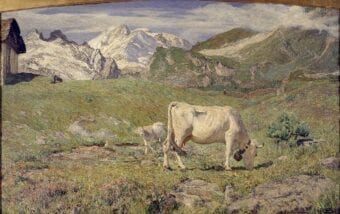
His nineteenth-century preferences informed what Vitali looked for in twentieth-century art. Indeed, he never appreciated avant-gardes like Futurism much, nor Metaphysical art, but he loved and wrote much about twentieth-century European artists including Amedeo Modigliani, Alberto Giacometti, Marino Marini, Arturo Martini, Carlo Carrà, Arturo Tosi, and, obviously, Giorgio Morandi. Within the twentieth-century panorama, Morandi was one of Vitali’s favorite artists, the subject of many of his essays, and his friend, but perhaps their strongest tie was Vitali’s work on Morandi’s general catalogue.34
Vitali’s opinion of Metaphysical art in general and what he thought about Giorgio de Chirico in particular comes through in reading what Riccardo Jucker said to Carlo Bertelli: “You know, for Lamberto, knowing that I have a de Chirico is already a punch to the stomach.”35 Vitali disliked the lack of Italianness he perceived in de Chirico’s work, and he expressed an aversion to German Romanticism and figures such as Arnold Böcklin and Max Klinger, whom de Chirico referenced.36
In writing on Carrà, Vitali explained why he disagreed with the northern tendencies of de Chirico’s Metaphysical art, and a primary reason was its relationship with the past: “Carrà, unlike other contemporary painters in whose work we can feel superstructures that hide their ultimate dryness, remains grounded as a Piedmontese should be, with his emotional cosmic vision intact.”37 When Vitali wrote about Carra’s Piedmontese attitude, he was thinking, certainly, about L’amante dell’ingegnere (The Engineer’s Lover, 1921; figure 5),38 for he did appreciate Metaphysical art that he saw as more Italian in its language: “Progressive deletion of elements […] changed relationship between figure and setting; but most of all, decisive landscape for a more realistic representation and substantial mutation of pictorial solutions.”39 Referring to the Italian pictorial language used by Carrà, which the painter himself in 1919 called “my Metaphysical Italianism,” 40 Vitali recognized that Carrà took inspiration from de Chirico’s figurative repertoire and strange titles, but “when the pure painterly language is touched, substantial differences intervene immediately.”41
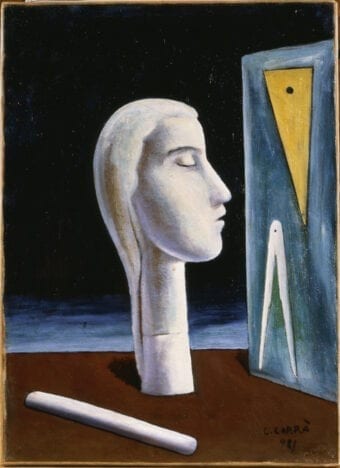
When Vitali wrote about Morandi’s Metaphysical period, he tried to be as objective as possible, but nonetheless revealed what peeved him. Thus, in 1964, in his introduction to a monograph of Morandi’s paintings, he maintained a negative point of view on Metaphysics:
Metaphysical painting or, rather (to be more thorough), the so-called Metaphysical painting of Morandi, conceived between mid-1918 and mid-1920, two precise years, is quite different. It is a sober kind of painting, nourished by experiences of geometry, or rather born of a true and proper craving for geometry, without any sensual allure, and, altogether, with a fundamental purist rigor, with nostalgia for the very first Renaissance, for which the objects are realized with the same cold passion.42
The phrase “so-called Metaphysical painting of Morandi” asserts a substantial difference between his work and Metaphysical painting as intended by de Chirico: similar language arises elsewhere in the catalogue and in other texts by Vitali addressing the years between 1918 and 1920.43 With this expression he underlined his thinking: Morandi was not a painter to be recognized as part of a group; he was unique in the twentieth-century panorama, and indebted only to masters of the past, for instance, in Roberto Longhi’s assessment, “Giotto, Masaccio, Piero, Bellini, Tiziano, Chardin, Corot, Renoir, Cézanne.”44
Vitali wrote on Morandi’s “geometric fury” in those “so-called Metaphysical” years,45 and about how the paintings are without “sensuality” and done with “cold passion” – a singular choice of words that Vitali never otherwise used in relation to his favorite painter. On the palette of Morandi’s Metaphysical paintings, Vitali wrote that “the painter wants to chastise himself,” a strong expression indicating that he did not find pleasure in looking at these works. Because he liked continuity in art, and artistic coherence, he never came to appreciate this phase of Morandi’s work, which might be considered as a parenthesis in his production.46 Vitali was not able to understand a temperamental process “that does not produce anymore a sense of composition, but fragments, broken lines, emotionally acute reality lacerations that give a sensation of a split personality.”47 Another passage reads:
All of the pictures in the series were achieved by observing a composition of individual objects, arranged before his eyes, without even the smallest concession to imagination. One notes the artist’s intention of translating these distinct elements as pure forms, which verge on abstraction with the cold passion of intellectual lucubrations.48
It is significant that Vitali explained the pictorial tendencies to abstraction as deplorable because they are only intellectual speculations.49 This indicates his “weak point” as an art historian: in the 1970s, he was not ready – fifty years after the Metaphysical period – to complete the historicizing of this pictorial phase of Morandi’s career.
Talking about Morandi’s last four Metaphysical paintings of 1919, Vitali pointed to “a return to a less rarefied world.” 50 What changed were the compositions, which recalled, for Vitali, Paul Cézanne, precisely La Pendule noire (The Black Marble Clock, 1869–1871): Morandi had returned to the “right” tradition and forgotten de Chirico.51 It was a return to reality – Morandi’s reality of course – that Vitali appreciated more because there was comfort in this way of representing the vast variation of realities and sentiments. The palette and the subjects’ arrangement express every shade of emotional consolation. Just before this “return to a less rarefied world,” the palette and brushstrokes were bringing back a sense of anxiety in the painter’s creation of a reality distant from the observer’s. We know that Morandi was in crisis in this period – like de Chirico, Carrà, and Mario Sironi – because of the war. More or less at the same time, between 1916 and 1919, he painted three beautiful flower vases with pink and blue backdrops, which successfully demonstrate this crisis, with all his second thoughts and reworkings. The Metaphysical reality pushes out the observer, and creates an abstract space, and this seems like an experiment for Morandi, who, at the threshold of being thirty years old, was searching for a new personal voice. Vitali considered this extreme experiment to be a fortunately brief aberration in the artist’s production.
In 1920, after these paintings, Vitali deemed Morandi’s Metaphysical phase over. The transition was almost complete in Fiori (Flowers, 1920) and Natura morta con tavolo (Still Life with Round Table, 1920), and not by chance Vitali acquired both works for his collection (figure 6). Certain elements of the second painting in particular place it in between the two phases. Vitali deemed it a “bridge”:
The great Natura morta con tavolo is the work that forms a bridge between the so-called Metaphysical period and the phase which immediately followed. It […] brings to light the character of the truest Morandi; if the composition is always orchestrated with a perfect knowledge of spaces and interspaces, the pictorial language foreshadows all that will come after, leading to today. Objects are no longer indicted, imprisoned by heavy contours […]. There is, rather, a general intonation reminiscent of Piero della Francesca […] and above all, a perfectly equilibrated conquest between rationality and feeling, without which one would prevail over the other.52
This well explains why he chose to buy Natura morta con tavolo in particular. The wonderful and pivotal painting set the stage for two years of “intellectual lucubrations,” “cold light,” and deplorable “abstraction.”53 Vitali likely appreciated in this painting the line in the background, behind the round table, that is not a Metaphysical scoria, but just wallpaper. It returns to the common things that Vitali liked to find in Morandi’s painting – the poetry of everyday objects, wherein both the artist and the author can find peace and comfort. However, for Vitali this is not really a question of subject, but rather, of painting – pure painting – and palette.
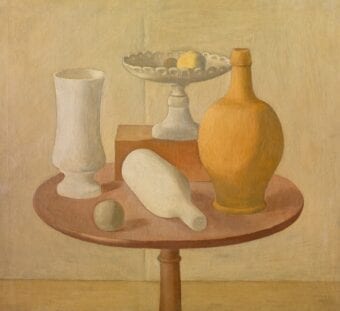
It is strange that Il cactus (The Cactus, 1917–19; figure 7) and the “lost” Self-portrait (1917–19; figure 8) on its verso go unmentioned in these texts. Morandi asked that the image on the back be covered over after the work’s exhibition in San Francisco in 1939, before the object became the property of Rino Valdameri, in 1940.54 When he made the request, the painting was in Vitali’s collection, and we know thus know that Vitali was complicit in the artist’s hiding the unloved side of the canvas. However, Vitali’s introduction to Morandi’s general catalogue published in 1977 gives details of the painting, for example the dimensions (which are, of course, those of Il cactus). It seems that he wanted to leave some sign to posterity, though probably not because his judgement had changed, but rather because he felt a certain culpability in keeping the secret; he was probably divided between respecting the artist’s desire and avoiding being part of the “crime.”
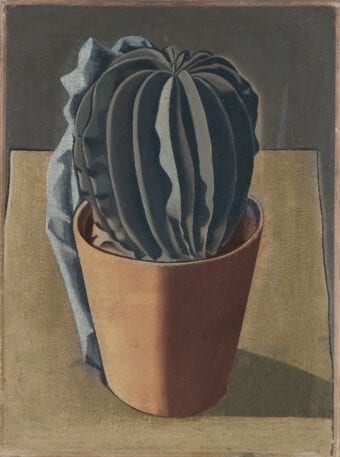
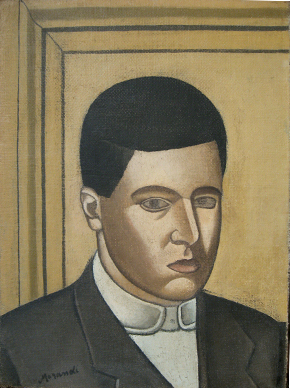
This brings us back to the primary question: how can we synthesize Vitali’s taste? It is clear that he appreciated the more pictorial aspect, maybe even the picturesqueness, of the last Metaphysical paintings. For him, pure painting was everything, in line with theories of pure visibility. He clearly kept alive the memory of Benedetto Croce, but also looked to Roberto Longhi, who was a fundamental point of reference for Morandi especially. Vitali’s 1937 description of the Reinhart collection, mentioned at the beginning of the present essay, also explains the kind of painting he preferred, and the fil rouge he followed in art history:
The concept that painting, as the nineteenth-century French innovators interpreted it – from Delacroix to the Impressionists – was born in Venice, and then flourished in all of Europe, legitimizes the presence of works here by Tintoretto, Jacopo Bassano, and Guardi. Tintoretto is balanced and yet open to brief pictorial solutions […] defined with a few synthetic brushstrokes. […] Tintoretto and Bassano, due to the expressionistic function of color and stylistic deformations, which result in an enhancement of dramatic pathos, [have] expressive and pictorial power.55
In painting, Vitali loved gesture, materiality, and the passion that for him shines through in the very physical relationship an artwork offers, wherein the anxiety of the creative act is to be found. We should not forget that, as a collector, he was used to touching works of art – he truly had a tactile relationship with them.
Confirmation of this predilection is a list, archived at the Brera, regarding the donation of Morandi’s paintings to the museum (figure 9); it reveals that Vitali’s desire was to donate twenty paintings by the artist.56 The group starts with an early painting, a landscape painted in 1911 (figure 10), but the core of the Morandi donation dates from 1925 to 1945, allowing us to infer that this was Vitali’s favorite period of his oeuvre.57 These paintings evidence what the collector most admired: the rich materiality of the painted surface, the dusty colors, the atmospheric effect that melds objects and air. Regarding this sensibility, Fernanda Wittgens offered a perfect summation in her writings on the twentieth century: “We have indeed a critical conscience, but also a lot of epidermic sensitivity.”58
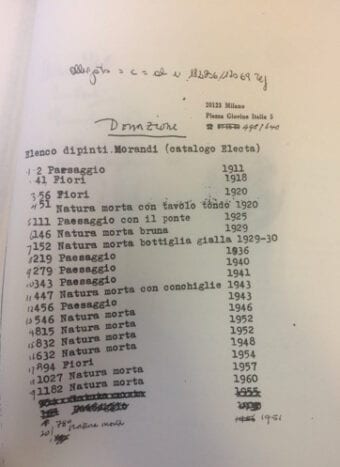
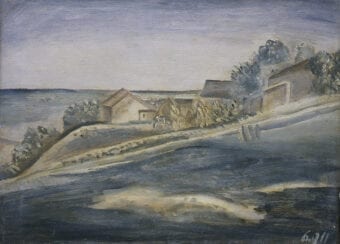
Bibliography
Bandera, Maria Cristina. “Giorgio Morandi. Il ritratto ritrovato.” Paragone. Arte, no. 81, September 2008: 3–18.
Bernardi, Erica. “Con D’Ancona, Modigliani e Longhi.” In Sono Fernanda Wittgens. Una vita per Brera, 95–104. Milan: Skira, 2018.
Bernardi, Erica. “Franco Russoli – Fernanda Wittgens. Le prime lettere tra Pisa, Milano e Parigi.” Concorso. Arti e Lettere, no. 4 (2012–14): 52–63.
Bernardi, Erica. “Franco Russoli museologo militante. Dal riordino del Poldi Pezzoli alla ‘grande Brera.’” In Franco Russoli Senza utopia non si fa la realtà. Scritti sul museo 1952–1977, edited by E. Bernardi, 19–57. Milan: Skira, 2017.
Bernardi, Erica. “La nascita del Fogg Museum di Harvard nella corrispondenza Forbes-Berenson (1915–1928).” Predella: Journal of Visual Studies, no. 34 (January 2014): 457–61.
Bertelli, Carlo. “Ricordo di Riccardo Jucker.” In La Collezione Jucker. Milan: Skira, 1992.
Bertelli, Carlo. “Rimembranze.” In Un milanese che parlava Toscano. Lamberto Vitali e la sua collezione, 12. Milan: Pinacoteca di Brera and Electa, 2001.
Bloch, Vitale. Giorgio Morandi, cartella con sei tavole a colori. Milan: Edizioni il Milione, 1954.
Calloud, Irene, ed. “Lamberto Vitali e la grafica.” Fondazione Memofonte website, https://www.memofonte.it/ricerche/lamberto-vitali-e-la-grafica/.
Carrà, Carlo. “L’italianismo artistico.” Valori Plastici, nos. 4–5 (April–May 1919): 1–5.
Daffra, Emanuela. “Per Brera, 1947–1957.” In Sono Fernanda Wittgens. Una vita per Brera, edited by Giovanna Ginex, 105–14. Milan: Skira, 2018.
D’Ancona, P. Valsecchi, and L. M. Vitali, eds. Dipinti dell’Ottocento italiano a Lugano. Lugano: Museo Caccia Villa Ciani; Bellinzona: Lens & Vescovi, 1948. Exhibition catalogue.
Delacroix, Eugène. Diario. Edited by Lamberto Vitali. Turin: Einaudi, 1954.
Dorfles, Gillo. “Lamberto Vitali. Una generosità da scoprire.” In Paolo Franci, L’altro Lamberto, n.p. Milan: Giorgio Lucini, 2001.
Fergonzi, Flavio. “Carlo Carrà. L’amante dell’ingegnere.” In La collezione Mattioli. Capolavori dell’avanguardia italiana, edited by F. Fergonzi, 231–43. Milan: Skira, 2003.
Folcio, Mara. “La collezione fotografica di Lamberto Vitali. Master’s thesis, Ca’ Foscari University of Venice, 2016–17.
Franchi, Raffaello. “Giorgio Morandi, ‘La terrazza.’” La raccolta 1, nos. 9–10 (November 15– December 15, 1918): 117–18.
Ginex, Giovanna. “Fernanda Wittgens.” In Sono Fernanda Wittgens. Una vita per Brera, edited by G. Ginex, 22–27. Milan: Skira, 2018.
Iato, Valeria. “Dalle proposte per modernizzare i musei alla passione per l’arte del proprio tempo: gli scritti di Lamberto Vitali degli anni venti e trenta.” In Un milanese che parlava toscano. Lamberto Vitali e la sua collezione, 22–30. Milan: Pinacoteca di Brera and Electa, 2001.
“La settimana dell’arte. I risultati.” L’Ambrosiano, March 3, 1934.
Longhi, Roberto. Catalogo della mostra di dipinti di Giorgio Morandi. Florence: Galleria del Fiore, 1945. Exhibition catalogue.
Madesani, Angela, ed. Lino Pesaro. Storia di un mercante creatore di collezioni. Milan: Gallerie Maspes, 2017.
Marchiori, Giuseppe. Luigi Bartolini. Milan: Hoepli, 1936.
Metaphysical Masterpieces, 1916–1920. Morandi, Sironi, and Carrà. New York: Center for Italian Modern Art, 2019. Exhibition catalogue.
Modigliani, Ettore. Memorie. La vita movimentata di un grande soprintendente di Brera. Edited by Marco Carminati. Milan: Skira, 2019.
Paoli, Silvia, ed. Lamberto Vitali e la fotografia. Collezionismo, studi e ricerche. Cinisello Balsamo: Silvana Editoriale, 2004.
Pescarmona, Daniele. L’irrompere delle modernità dell’Otto e del Novecento nella Pinacoteca di Brera, pdf available at https://pinacotecabrera.org/wp-content/uploads/2015/03/Brera-storia2.pdf.
Pirovano, Magda. “Appunti per una biografia di Lamberto Vitali.” In Un milanese che parlava toscano, 35–41. Milan: Pinacoteca di Brera and Electa, 2001.
Rovati, Federica. “[19] Giorgio Morandi. Natura morta” (1919). In L’arte del primo Novecento. Verona: Einaudi, 2014.
Russoli, Franco. “La cultura a Milano o ricchezze sprecate.” Pirelli. Rivista di informazione e tecnica 16, no. 2 (March–April 1963): 94–99.
Salvagnini, Sileno. Il sistema delle arti in Italia. 1919–1943. Milan: Minerva Edizioni, 2000.
Vendita all’Asta. Bologna: Nuova Adma Casa d’Aste, May 13–14, 1997. Auction catalogue.
Venturi, Lionello. Pittura contemporanea. Milan: Hoepli, 1947.
Vitali, Lamberto, “Disegni di Modigliani.” In Arte Moderna italiana. Milan: Hoepli, 1929.
Vitali, Lamberto. Giorgio Morandi, opera grafica. Torino: Einaudi, 1954.
Vitali, Lamberto. “Introduzione.” In Giorgio Morandi, pittore. Milan: Edizione del Milione, 1964, 1965.
Vitali, Lamberto. “L’incisione italiana del Novecento. I selvaggi: Carlo Carrà.” Domus 37 (January 1931): 45–48.
Vitali, Lamberto. L’incisione italiana moderna. Milan: Hoepli, 1934.
Vitali, Lamberto. “L’incisione moderna in Italia. De Chirico, Severini, Campigli.” Domus 45 (September 1931): 73–75.
Vitali, Lamberto. “Le grandi collezioni. I. La raccolta Oskar Reinhardt a Wintertour.” Emporium 85, no. 506 (1937): 59–74.
Vitali, Lamberto. Lettere dei Macchiaioli. Turin: Einaudi, 1953.
Vitali, Lamberto. “Lo scultore Giacomo Manzù.” Emporium vol. 87, n. 521 (1936): 243–54.
Vitali, Lamberto. “Marini.” In Quaderni d’arte. Florence: Vallecchi, 1946.
Vitali, Lamberto. “Marino Marini.” In Arte Moderna Italiana. Milan: Hoepli, 1937.
Vitali, Lamberto, ed. Morandi, catalogo generale. Milan: Electa, 1977.
Vitali, Lamberto. Mostra di Modigliani. Milan: Alfieri & Lacroix, 1946.
Vitali, Lamberto. Preface to La donazione Emilio e Maria Jesi, edited by Gian Alberto Dell’Acqua. Milan: Amici di Brera, 1981.
Vitali, Lamberto. Preferenze. Pescia: Editoriale Domus, 1950.
Wittgens, Fernanda. “Doni alla Pinacoteca di Brera.” In Bollettino d’arte. Ministero della pubblica istruzione. Direzione generale delle antichità e belle arti 40, no. 4 (October–December 1955): 369.
Wittgens, Fernanda. “Pinacoteca di Brera.” In I Musei di Lombardia, 4–5. Milan: Istituto Lombardo di Scienze e Lettere, 1957.
How to cite
Erica Bernardi, “Intellectual lucubrations”: Lamberto Vitali, Giorgio Morandi, and Metaphysical Art,” in Erica Bernardi, Antonio David Fiore, Caterina Caputo, and Carlotta Castellani (eds.), Metaphysical Masterpieces 1916–1920: Morandi, Sironi, and Carrà, monographic issue of Italian Modern Art, 4 (July 2020), accessed [insert date].
- For this essay I would like to express my gratitude to Flavio Fergonzi, Giovanna Ginex, James M. Bradburne, Laura Mattioli, Maria Cristina Passoni, Leonardo Piccinini, Adriana Volpi, Chiara Fabi, Stefano Menichini, Giulia Nicita, Chiara Trebaiocchi, Nicole Boyd, and Mark Gillespie. For more on Lamberto Vitali, see Un milanese che parlava Toscano. Lamberto Vitali e la sua collezione (Milan: Pinacoteca di Brera and Electa, 2001); and Paolo Franci, L’altro Lamberto (Milan: Giorgio Lucini, 2001).
- On the Macchiaioli painters, see Lamberto Vitali, Lettere dei Macchiaioli (Turin: Einaudi, 1953).
- For Lamberto Vitali on Modigliani, see “Disegni di Modigliani,” in Arte Moderna italiana (Milan: Hoepli, 1929); and Mostra di Modigliani (Milan: Alfieri & Lacroix, 1946).
- This list is taken from a report made by the Pinacoteca di Brera upon the donation of Vitali’s collection. It is incomplete and cannot be attributed to an individual author, but at that time the following individuals, among others, were involved in the selection of artworks: Pietro Petraroia (Director of the Brera), Luisa Arrigoni, Maria Teresa Binaghi Olivari, and Rosalba Tardito. The documents are archived at the Brera, and the report’s folder contains documents related to the donation starting from 1975. One of the first documents is signed by Giovanni Spadolini, Ministro per i beni culturali e ambientali, in September 1975, when Franco Russoli was trying to complete his “big Brera” project with Vitali. See also Lamberto Vitali,“Lo scultore Giacomo Manzù,” Emporium, 87 (1936): 243–54; “Marino Marini,” in Arte Moderna Italiana (Milan: Hoepli, 1937); “Marini,” in Quaderni d’arte (Florence: Vallecchi, 1946); and Giorgio Morandi, opera grafica (Torino: Einaudi, 1954).
- On Vitali’s biography, see Magda Pirovano, “Appunti per una biografia di Lamberto Vitali,” in Un milanese che parlava toscano, 35–41; and http://www.lombardiabeniculturali.it/percorsi/vitali/1/.
- See Lamberto Vitali, “Le grandi collezioni. I. La raccolta Oskar Reinhart a Winterthur,” Emporium 85, no. 506 (1937): 59–74.
- There he worked on his translation of Delacroix’s diary. See Eugène Delacroix, Diario, ed. Lamberto Vitali (Turin: Einaudi, 1954).
- Vitali was director of Emporium between 1935 and 1938, before having to leave his position because of the racial laws. It is during this period and precisely in this magazine that he started to publish about photography.
- See Valeria Iato, “Dalle proposte per modernizzare i musei alla passione per l’arte del proprio tempo. Gli scritti di Lamberto Vitali degli anni venti e trenta,” in Un milanese che parlava toscano, 22–30.
- The Preferenze anthology of Lamberto Vitali’s texts (Milan: Editoriale Domus, 1934, 1950) is missing essays that are instead published in Domus (they can be found at https://www.memofonte.it/ricerche/lamberto-vitali-e-la-grafica/).
- On Vitali and photography, see Silvia Paoli, ed., Lamberto Vitali e la fotografia. Collezionismo, studi e ricerche (Cinisello Balsamo: Silvana Editoriale, 2004); and Mara Folcio, “La collezione fotografica di Lamberto Vitali” (master’s thesis, University of Ca’ Foscari, 2016–17).
- Lamberto Vitali, preface to La donazione Emilio e Maria Jesi, ed. Gian Alberto Dell’Acqua (Milan: Amici di Brera, 1981), n.p. Throughout this essay translations from the Italian are by CIMA staff.
- On Vitali, Barr, and Soby, see Daniele Pescarmona, “L’irrompere delle modernità dell’Otto e del Novecento nella Pinacoteca di Brera,” pdf available at https://pinacotecabrera.org/wp-content/uploads/2015/03/Brera-storia2.pdf, 9.
- I deduced the galleries Vitali frequented and his interests from the many auction catalogues listed in the Vendita all’Asta auction catalogue for the sale of Vitali’s library (May 13–14, 1997), produced by Nuova Adma Casa d’Aste, Bologna. Fortunately, the auction was intercepted by the Milanese Soprintendenza, which bought all the books; they are now kept in the Braidense Library, Milan).
- Lamberto Vitali, “Artisti e pubblico,” in Preferenze, 13–17; see also “Crisi della pittura?,” in ibid., 23–29.
- Ibid., 29. Focillon and Vitali were both interested in engravings, and they were from the same generation.
- This is confirmed in the auction list of Vitali’s books, see note 16.
- Vitali wrote on L’Ambrosiano magazine in 1934, see Salvagnini, Il sistema delle arti, 151, note 59. In the same year, Vitali participated in “La settimana dell’arte,” organized by the Galleria Milano to promote contemporary artists including Sironi, Carrà, Marini, Manzù, Casorati, and others; the results weren’t good, see “La settimana dell’arte. I risultati,” L’Ambrosiano, March 3, 1934.
- After the reading of Reinhardt’s will in 1950, Vitali probably formulated an idea to create a museum for the Reinhardt collection at his mentor’s house in Winterthur. See Carlo Bertelli, “Rimembranze,” in Un milanese che parlava Toscano, 12.
- Gillo Dorfles, “Lamberto Vitali. Una generosità da scoprire,” in L’altro Lamberto, n.p. Frequently, Vitali’s collection process recalled that of American museum directors who studied with Paul J. Sachs at Harvard University, in the lineage of Bernard Berenson in acquiring for the Fogg Museum at Harvard. See Erica Bernardi, “La nascita del Fogg Museum di Harvard nella corrispondenza Forbes-Berenson (1915–1928),” Predella: Journal of Visual Studies, no. 34 (January 2014): 457–61.
- See Erica Bernardi, “Con D’Ancona, Modigliani e Longhi,” in Sono Fernanda Wittgens. Una vita per Brera, ed. G. Ginex (Milan: Skira, 2018), 95–104.
- See Giovanna Ginex, “Fernanda Wittgens,” in Sono Fernanda Wittgens, 22–27; and Erica Bernardi, “Wittgens, Russoli e Icom: dalla ricostruzione al museo come strumento di comunicazione di massa (1945–1977),” in Per i 70 anni di Icom Italia, ed. Adele Maresca (forthcoming in 2020).
- Ibid.
- Ettore Modigliani was born into Jewish family; for this reason, in 1934 the Fascist government transferred him at l’Aquila. Following the adoption of racial laws, he was expelled by the state in 1939. During wartime, he hid in the countryside of central Italy with his family to avoid imprisonment in a concentration camp. In 1946 he was reinstated at the Brera gallery and dealt with the reconstruction of buildings destroyed by bombings. During his absence, Fernanda Wittgens acted as the Brera’s director. See Ettore Modigliani, Memorie. La vita movimentata di un grande soprintendente di Brera, ed. Marco Carminati (Milan: Skira, 2019). On the Societè des Amis du Musée de Gand, see Les Amis du Musée de Gand: 65 ans d’activitè (19 octobre–19 jannvier 1964) (Gand: Museum voor Schone Kunsten: 1963).
- See Ginex, “Fernanda Wittgens,” 22–27; and Modigliani, Memorie, 266–77.
- See Franco Russoli, Senza utopia non si fa la realtà. Scritti sul museo 1952–1977, ed. Erica Bernardi (Milan: Skira 2017); and E. Bernardi, “Franco Russoli – Fernanda Wittgens. Le prime lettere tra Pisa, Milano e Parigi,” Concorso. Arti e Lettere, no. 4 (2012–14): 52–63.
- Erica Bernardi, “Franco Russoli museologo militante. Dal riordino del Poldi Pezzoli alla ‘grande Brera,’” in Senza utopia non si fa la realtà, 34.
- See Pescarmona, “L’irrompere delle modernità;” and Ginex, “Fernanda Wittgens,” 54–58.
- See Paolo D’Ancona, Marco Valsecchi, and Lamberto Vitali, eds., Dipinti dell’Ottocento italiano a Lugano (Lugano: Museo Caccia Villa Ciani; Bellinzona: Lens & Vescovi, 1948). The exhibition was curated by Wittgens; see Ginex, “Fernanda Wittgens,” 88 n. 136.
- Fernanda Wittgens, “Doni alla Pinacoteca di Brera,” Bollettino d’arte. Ministero della pubblica istruzione. Direzione generale delle antichità e belle arti 40, no. 4 (October–December 1955): 369.
- This was a tendency at the time in Lombard collections, and Pietro Feroldi did the same (see Salvanigni, Il sistema delle arti, 325), as did Riccardo Jucker and others. It is interesting also to underline that Feroldi started to buy twentieth-century art beginning with a late 1920s Carrà painting (see ibid., 326). The critical fortune of this group of Italian painters started exactly in these years. Archaeological collections were, of course, also a real passion for Vitali, who considered it necessary for a city to have a good archaeological museum, which Milan lacked, and which was part of the reorganization project of Milanese museums during the 1960s. See Franco Russoli, “La cultura a Milano o ricchezze sprecate,” Pirelli. Rivista di informazione e tecnica, Milano 16, no. 2 (March–April 1963): 94–99.
- Emanuela Daffra, “Per Brera, 1947–1957,” in Sono Fernanda Wittgens, 105–14.
- Fernanda Wittgens, “Pinacoteca di Brera,” in I Musei di Lombardia (Milan: Istituto Lombardo di Scienze e Lettere, 1957), 4–5.
- Lamberto Vitali, ed., Morandi, catalogo generale (Milan: Electa, 1977).
- Carlo Bertelli, “Ricordo di Riccardo Jucker,” in La Collezione Jucker (Milan: Skira, 1992), 17; and Carlo Bertelli, “Rimembranze,” in Un milanese, 13.
- Lamberto Vitali, “Variazioni metafisiche di Carrà” (1945), in Preferenze, 105; and “L’incisione moderna in Italia. De Chirico, Severini, Campigli,” Domus, no. 45 (September 1931): 73–75. In 1954, Vitale Bloch wrote something similar: “Già negli anni metafisici l’arte di Morandi appare libera dal bagaglio della cultura greco-tedesca di de Chirico e non so se appena la sfiorino il sottile umorismo e la poetica ironia di Carrà. In rapporto ai ‘metafisici’ veri e propri Morandi si comporta come un purista” (Already in the Metaphysical years, Morandi’s art appears free from the baggage of de Chirico’s Greco-German culture and I do not know whether the subtle humor and the poetic irony of Carrà touch it. In relation to the actual “metafisici,” Morandi behaves as a purist). Bloch, Giorgio Morandi, cartella con sei tavole a colori (Milan: Edizioni il Milione, 1954).
- Lamberto Vitali, “L’incisione italiana del Novecento. I selvaggi: Carlo Carrà,” Domus, no. 37 (January 1931): 45–48.
- On the Piedmontese – or more precisely, Valsesian – skies, see Flavio Fergonzi, “Carlo Carrà. L’amante dell’ingegnere,” in La collezione Mattioli. Capolavori dell’avanguardia italiana, ed. F. Fergonzi (Milan: Skira, 2003), 231–43.
- Vitali, “Variazioni metafisiche di Carrà,” 112.
- Carlo Carrà, “L’italianismo artistico,” Valori Plastici, nos. 4–5 (April–May 1919): 1.
- “Quando si tocca il puro linguaggio pittorico, intervengono subito differenze sostanziali.” Ibid., 107.
- Lamberto Vitali, introduction to Giorgio Morandi, pittore (Milan: Edizione del Milione, 1964), 23.
- More recently, Federica Rovati wrote something similar about Morandi’s Metaphysical period: “Fra il 1918 e il 1919 Morandi eseguì un ciclo di diciannove nature morte cui viene per consuetudine attribuita la qualifica metafisica, una definizione impropria eppure pregnante per il processo di trasfigurazione subíto dagli oggetti della vita quotidiana” (Between 1918 and 1919 Morandi painted a cycle of nineteen still lifes to which critics customarily attributed a metaphysical qualification, an improper yet pregnant definition for the process of transfiguration suffered by objects of everyday life). See his “[19] Giorgio Morandi. Natura morta” (1919), in L’arte del primo Novecento (Verona: Einaudi, 2014).
- This list appears in Roberto Longhi, Catalogo della mostra di dipinti di Giorgio Morandi (Florence: Galleria del Fiore, 1945). Vitali was an amateur, and the intellectual guidance of Longhi was fundamental.
- Incidentally, during the years of this geometric fury, Morandi was teaching geometric drawing at an elementary school.
- Vitali compares Morandi and Luigi Bartolini in his book on engraving: L’incisione italiana moderna (Milan: Hoepli, 1934), 47–49. See also Salvagnini, Il sistema delle arti, 106–08.
- See Salvagnini, Il sistema delle arti, 109.
- Vitali, Giorgio Morandi, pittore, 23–24. In 1918, in the first article published on Morandi, in the magazine La Raccolta, Raffaello Franchi talks about abstraction in a similar way: “Esse sono costruzioni astratte quasi algebriche tutte dominate dalla manualità e dalla sensibilità d’un pittore, non da quella d’un metafisico.” (These are almost algebraic abstract constructions, all dominated by the manuality and the sensibility of a painter, not by that of a “metafisico.”) Franchi, “Giorgio Morandi, ‘La terrazza,’” La Raccolta 1, nos. 9–10 (November 15–December 15, 1918): 117–18.
- About such abstract tendencies, Vitali had previolusly written: “Gli astrattisti, questi puristi […] si pongono problemi schiettamente pittorici, ma chiudendosi in una formula, rinunziano ad abbordarli tutti quanti […]. La loro posizione, apparentemente d’avanguardia, è in sostanza schiettamente anacronistica, sia che puntino sui francesi come Soldati, De Amicis, Reggiani, Bogliardi, Ghiringhelli, o sui tedeschi come Licini.” (Abstract artists, these purists […] pose for themselves purely pictorial problems, but they close themselves off in a formula, they give up on picking up all of them […]. Their position, apparently avant-garde, is substantially anachronistic, both when they aim toward the French, like Soldati, De Amicis, Reggiani, Bogliardi, and Ghiringhelli, or toward the Germans, like Licini.) See Vitali, Domus, no. 88 (1935); quoted in Salvagnini, Il sistema delle arti, 33, note 60.
- Ibid., 25.
- Vitali, Giorgio Morandi, pittore, 24.
- Ibid., 25.
- This point of view around abstraction is a clear generational sign. Lionello Venturi, who was five years older than Vitali, wrote about Morandi: “Nel 1920 le sue forme composte in un’architettura astratta erano ancora schemi di oggetto, simboli di valori plastici e geometrici. Ma sette anni dopo quelle forme avevano già ricevuto dal colore quel tanto necessario di vibrazione e di deformazione perché potessero vivere nel mondo della sensibilità e della fantasia.” (In 1920, his forms composed in an abstract architecture were still object schemas, symbols of plastic and geometric values. But seven years later those forms were receiving, by way of color, the necessary amount of vibration and deformation so that they could subsist in worlds of sensibility and fantasy.) Venturi, Pittura contemporanea (Milan: Hoepli, 1947), 47–48.
- Maria Cristina Bandera, “Giorgio Morandi. Il ritratto ritrovato,” Paragone. Arte, no. 81 (September 2008): 3–18.
- Vitali, “Le grandi collezioni,” 59.
- The paintings are ordered: Vitali 2, 41, 56, 51, 111, 146, 152, 219, 279, 343, 447, 457, 546, 815, 832, 632, 894, 1027, 1182, 780. The documents about Vitali’s donation and the 2001 exhibition of his collection at the Brera are conserved in the museum archives under “Progetto Vitali” and “Mostra Vitali. Progetti allestimento.” In the same document two entries in the list are deleted, but it is possible to see that one is Vitali 954.
- Vitali had both a deep relationship with the artist and no problem buying whatever he desired.
- Ginex, “Sono Fernanda Wittgens,” 56.

